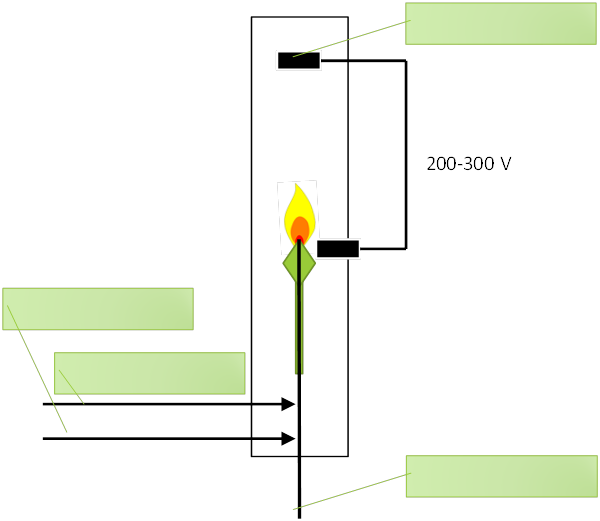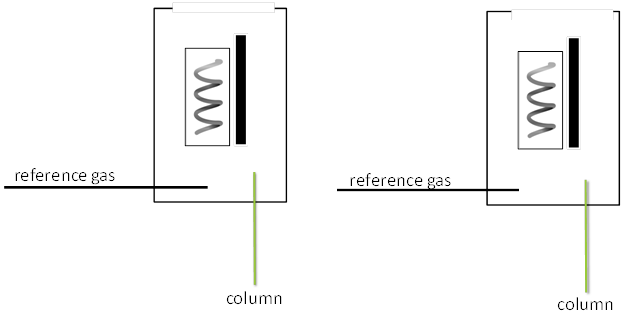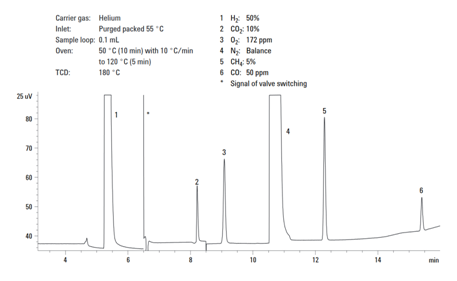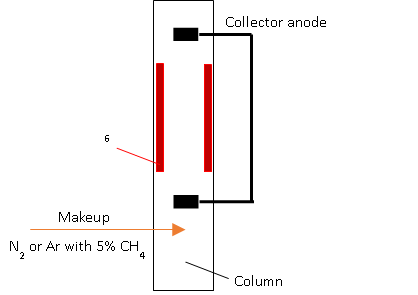Gas Chromatographic Detectors
- Page ID
- 284057
\( \newcommand{\vecs}[1]{\overset { \scriptstyle \rightharpoonup} {\mathbf{#1}} } \) \( \newcommand{\vecd}[1]{\overset{-\!-\!\rightharpoonup}{\vphantom{a}\smash {#1}}} \)\(\newcommand{\id}{\mathrm{id}}\) \( \newcommand{\Span}{\mathrm{span}}\) \( \newcommand{\kernel}{\mathrm{null}\,}\) \( \newcommand{\range}{\mathrm{range}\,}\) \( \newcommand{\RealPart}{\mathrm{Re}}\) \( \newcommand{\ImaginaryPart}{\mathrm{Im}}\) \( \newcommand{\Argument}{\mathrm{Arg}}\) \( \newcommand{\norm}[1]{\| #1 \|}\) \( \newcommand{\inner}[2]{\langle #1, #2 \rangle}\) \( \newcommand{\Span}{\mathrm{span}}\) \(\newcommand{\id}{\mathrm{id}}\) \( \newcommand{\Span}{\mathrm{span}}\) \( \newcommand{\kernel}{\mathrm{null}\,}\) \( \newcommand{\range}{\mathrm{range}\,}\) \( \newcommand{\RealPart}{\mathrm{Re}}\) \( \newcommand{\ImaginaryPart}{\mathrm{Im}}\) \( \newcommand{\Argument}{\mathrm{Arg}}\) \( \newcommand{\norm}[1]{\| #1 \|}\) \( \newcommand{\inner}[2]{\langle #1, #2 \rangle}\) \( \newcommand{\Span}{\mathrm{span}}\)\(\newcommand{\AA}{\unicode[.8,0]{x212B}}\)
Learning Objectives
All students are expected to:
- Evaluate the suitability of three common detectors (FID, TCD, and ECD) for different analytes
- Explain the operation principle of these detectors
- Differentiate these detectors in terms of selectivity and other properties (destructive, bulk, concentration/ mass depending) with regard to their suitability for different application
Quiz GC Detectors
Provide handwritten answers and bring them to the class
- Define the limit of detection, dynamic range, linear range and also significance of these parameters when selecting a detector
- Describe how FID works, provide its significant characteristics and optimization parameters
- Describe how ECD works, and describe its typical operation parameters
- Describe how TCD works, and describe its typical operation parameters
- Define the main classifications of common chromatographic detectors and give examples in terms of:
- Concentration vs. mass flow
- Selective vs. universal
- Destructive vs. nondestructive
A. Flame Ionization detector (FID)
- Fill the missing labels for the FID detector diagram below.

- Explain the purpose of using each gas.
- Explain the operational principle of FID.
- Which analytes can be analyzed on an FID and which cannot?
B. Thermal conductivity detector (TCD)
- Sketch the flow of the molecules in a single cell TCD for the 2 scenarios shown below
- a reference gas passing through the filament
- an analyte in a carrier gas passing through the filament

- Why is a valve switching required for the application shown below?


Hint: Consider thermal conductivities listed.
C. Electron Capture detector (ECD)
- Sketch fast β- and thermal electrons e-, makeup gas and carrier gases, analyte species CX in the following three scenarios for ECD
- Only the carrier gas is passing through the ECD
- Both carrier and makeup gases are passing through the ECD
- The carrier gas with an analyte and makeup gas are passing through the ECD
a)

b)

c)

- Write three reactions, which occur in an ECD.
- Which analytes can be analyzed using an ECD?
D. GC detector characteristics
- List all possible detectors for the analytes in the following samples:
- Total petroleum hydrocarbons (TPH) in gasoline
- Nitrated polycyclic aromatic hydrocarbons (N-PAHs) extracted from air particulate matter
- Alcohol content in wine
- Chlorinated disinfectant products in water
- Polychlorinated biphenyls (PCBs) extracted from soil
- Hydrogen, CO2, methane, ethane and propane from biofuel production
- Considering their sensitivity, highlight the detector of choice for the analytes listed above in those samples.
- What solvents used for extraction would be detrimental to the detectors proposed in response to Q2?
- Which detector is universal and would be suitable for all analytes and why is it not the detector of choice?
- For which application would it be suitable to use two detectors in series and what would be the benefits of such a setup?
Contributors and Attributions
- Alena Kubatova, University of North Dakota (alena.kubatova@und.edu)
- Sourced from the Analytical Sciences Digital Library


